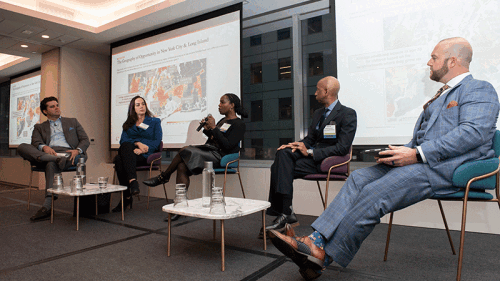U.S. multifamily has been outperforming other sectors for much of the recession recovery period and enjoying unprecedented capital investment flows from around the globe. At “The Next Best Bet in Multifamily” panel at the 2015 ULI Fall Meeting, industry-leading executives provided insight into the investor landscape and discussed what could be—and perhaps should be—influencing investor strategies.
Rent growth continues to soar in many cities, with investment in multifamily projects from both domestic and foreign capital showing few signs of abating. As values for city-center core properties reach new heights, and yields for value-added deals continue to decline, moderator Richard M. Gollis, cofounder and principal of the Concord Group LLC real estate advisers, asked, “How do investors best deploy capital into the multifamily sector? Will core still be the safest bet?”
Real estate “is finally an accepted asset class,” said Joe B. (Jody) Thornton Jr., executive managing director and president of HFF commercial real estate capital intermediaries. He said that investors were concerned in July and August about financial turmoil in China and the stock market, “but I think it was a time-out or a breather. We continue to see a tremendous amount of money that wants to get into this space” from various types of investors.
“Foreign capital has oftentimes looked to simply park capital in the U.S. real estate market, but recent trends show [that foreign investors are] looking for more yield,” said Thornton. “Chinese and Japanese capital [investors] in particular have liked the multifamily space.” He said that multifamily still is “the most aggressively priced capital, the most efficient space, and the most liquid of product types.” Thornton said he is seeing more deals in secondary markets, such as Kansas City, compared with the U.S. coasts, because they have been producing greater yields.
“It has become harder to find good deals to invest in the core market in gateway cities, [but] more opportunities may exist in secondary U.S. markets,” said Bill Nan Zhou, managing partner for the Elite Investment Fund and the U.S.-China Real Estate Investment Center, which provides joint venture equity for U.S. investment groups. Zhou said his company started investing in multifamily two years ago. Multifamily represents less than 1 percent of investments in China, where developers can make more money building condos, he said. Zhou said his firm began with a merchant-build strategy, and added a build-to-core strategy. A major trend in China is in absorbing existing inventory and reducing capacity; many smaller developers are pulling back because of the high land value and market uncertainty. U.S. investments are attractive, he added, as the Chinese market is cooling down.
Jeffery Daniels, managing director of AIG Global Real Estate Investment Corp., said AIG’s investment of $1 billion per year is focused on “build-to-core and value-add acquisition strategies.” AIG typically requires 5 to 10 percent coinvestment from its partners, but it has structures where partners have put up as much as 49 percent of the required equity, he said. Location, development expertise, partner capitalization, and other factors play into the amount of coinvestment. The firm is willing to pay off partners for a long-term investment in newly developed core assets.
Disruptive technology has changed the way people seek and invest in multifamily real estate opportunities, the panelists agreed. “We’ve seen it in digital marketing,” said Mary Ann King, president of Moran & Company and an expert in raising equity for multifamily deals. “Five years ago, we started to see renters use mobile apps for finding apartments, and now 90 percent of all renters find apartments through mobile apps or other online sources.”
Renters now “come in with as much information as the leasing agent,” said David Olney, managing director and head of multifamily investments for Berkshire Group. Disruptive tech also will change real estate itself, he said, by requiring adaptation for electric cars and charging stations as well as parking ratios once driverless cars become popular.
Olney said that using big data for investment strategy raises questions regarding how to aggregate and analyze them. Berkshire hired an in-house economist to pull data from the field and aggregate them, and also has regional investment teams that offer their own perspective, he said, which has resulted in “tension that is meaningful” between the data and on-the-ground analysis. Some historical data are predictive, he said, and can “inform you as to what strategies you’re best at and why you should be confident” and more aggressive with particular investment strategies.
Where is the next big deal? “Follow the bearded men to the next cool area,” quipped AIG’s Daniels, to audience laughter.
King advised investors to choose emerging neighborhoods: “Pick a submarket that will become more attractive than other submarkets during the period of your hold.” For the next few years, she said, “I’d probably look to southern California and Los Angeles,” particularly around the city’s Arts District, which should provide above-market investment returns over the long term. Downtown Los Angeles is expected to deliver about 4,000 housing units per year for each of the next several years, she said. Some attractive buying opportunities will emerge in this market while these units are leasing up. But, even with all of this new supply, she noted, “there is a huge unmet need for residential in downtown L.A., and I think it is a great place for a long-term investor to invest capital,” particularly with a leveraged deal and the advantage of today’s historically low interest rates.
What is the next product? The urban-core market trend has focused on millennials, with smaller apartments in amenity-rich buildings, said Gollis. “We joke that millennials will always be millennials, but they will become more like boomers,” he said, to more laughter. Life changes like getting a partner and having children are on the horizon for millennials, he said, and what will keep people in the city are good schools and certain amenities. At the same time, he said, a tremendous number of baby boomers and older people are moving into apartments in cities like Los Angeles.
“We see larger two- and three-bedroom units leasing for the same price per square foot as the smaller units” due to the confluence of millennials and empty nesters, said Daniels.
Olney predicted a continued trend in rental over for-sale multifamily housing. But that could change if the tipping point at which rising rents push people toward buying is reached, he added. “Housing affordability is critical.”
Kathleen McCormick, principal of Fountainhead Communications in Boulder, Colorado, writes about design and the environment, focusing on sustainability and healthy and resilient communities.




